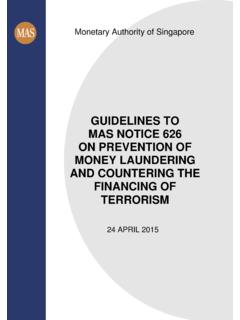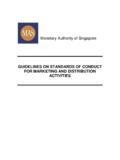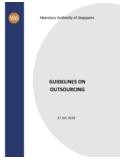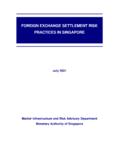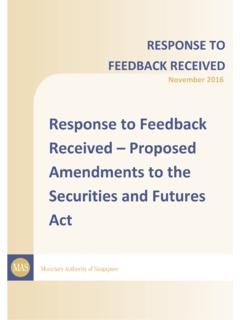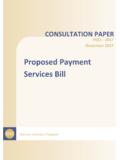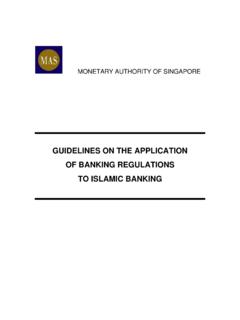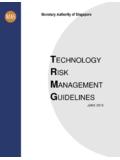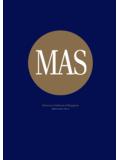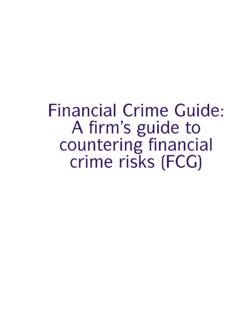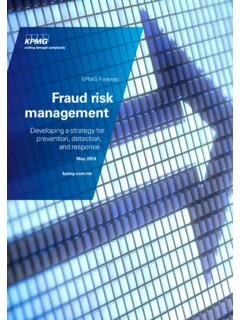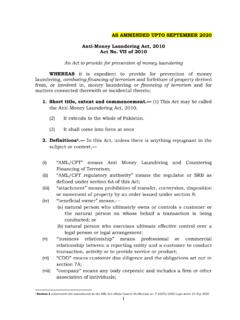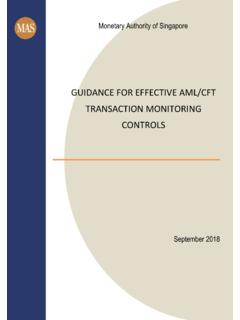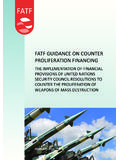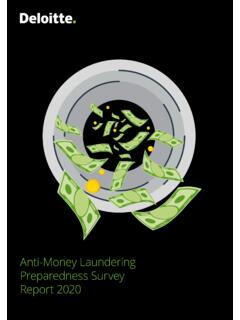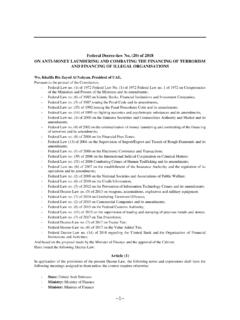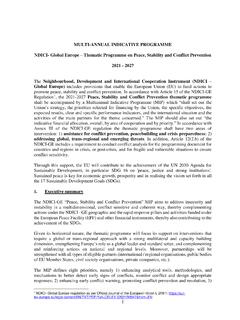Transcription of Guidelines to MAS Notice 626 (Clean - Final)
1 Monetary Authority of Singapore Guidelines TO MAS Notice 626 ON prevention OF money laundering AND countering THE FINANCING OF TERRORISM 24 APRIL 2015 TABLE OF CONTENTS 1 Introduction .. 1 2 Notice Paragraph 2 Definitions, Clarifications and Examples .. 5 4 Notice Paragraph 4 Assessing Risks and Applying a Risk-Based Approach .. 7 5 Notice Paragraph 5 New Products, Practices and Technologies .. 12 6 Notice Paragraph 6 Customer Due Diligence .. 13 7 Notice Paragraph 7 Simplified Customer Due Diligence .. 26 8 Notice Paragraph 8 Enhanced Customer Due Diligence .. 28 9 Notice Paragraph 9 Reliance on Third Parties .. 34 10 Notice Paragraph 10 Correspondent Banking and Similar Services .. 36 11 Notice Paragraph 11 Wire Transfers .. 38 14 Notice Paragraph 14 Suspicious Transactions Reporting .. 40 15 Notice Paragraph 15 Internal Policies, Compliance, Audit and Training .. 42 I Other Key Topics - Guidance to Banks on Proliferation Financing.
2 46 II Useful Links .. 49 APPENDIX A Examples of CDD Information for Customers (Including Legal Persons/Arrangements) .. 50 APPENDIX B Examples of Suspicious Transactions .. 53 For ease of reference, the chapter numbers in these Guidelines mirror the corresponding paragraph numbers in the MAS Notice 626 on prevention of money laundering and countering the Financing of Terrorism - Banks ( Chapter 2 of the Guidelines provides guidance in relation to paragraph 2 of the Notice ). Not every paragraph in the Notice has a corresponding paragraph in these Guidelines and this explains why not all chapter numbers are utilised in these Guidelines . Guidelines TO MAS Notice 626 ON prevention OF money laundering AND countering THE FINANCING OF TERRORISM 1 Introduction 1-1 These Guidelines provide guidance to all banks on the requirements in MAS Notice 626 on prevention of money laundering and countering the Financing of Terrorism Banks ( the Notice ).
3 These Guidelines should be read in conjunction with the Notice . 1-2 The expressions used in these Guidelines have the same meanings as those found in the Notice , except where expressly defined in these Guidelines or where the context otherwise requires. For the purposes of these Guidelines , a reference to CDD measures shall mean the measures as required by paragraphs 6, 7 and 8 of the Notice . 1-3 The degree of observance with these Guidelines by a bank may have an impact on the Authority s overall risk assessment of the bank, including the quality of its board and senior management oversight, governance, internal controls and risk management. 1-4 Key Concepts money laundering 1-4-1 money laundering ( ML ) is a process intended to mask the benefits derived from criminal conduct so that they appear to have originated from a legitimate source. Singapore s primary legislation to combat ML is the Corruption, Drug Trafficking and Other Serious Crimes (Confiscation of Benefits) Act (Cap.)
4 65A). A bank should refer to the Commercial Affairs Department s ( CAD ) website for more information. 1-4-2 Generally, the process of ML comprises three stages, namely (a) Placement The physical or financial disposal of the benefits derived from criminal conduct. (b) Layering The separation of these benefits from their original source by creating layers of financial transactions designed to disguise the ultimate source and transfer of these benefits. (c) Integration The provision of apparent legitimacy to the benefits derived from criminal conduct. If the layering process succeeds, the integration schemes place the laundered funds back into the economy so that they re-enter the financial system appearing to be legitimate funds. Terrorism Financing 1-4-3 Acts of terrorism seek to influence or compel governments into a particular course of action or to intimidate the public or a section of the public.
5 Banks are reminded of the definitions of terrorism set out in the Terrorism (Suppression of 1 Guidelines TO MAS Notice 626 ON prevention OF money laundering AND countering THE FINANCING OF TERRORISM Financing) Act (Cap. 325) ( TSOFA ) and the United Nations (Anti-terrorism Measures) Regulations (Rg. 1). 1-4-4 Terrorists require funds to carry out acts of terrorism, and terrorism financing ( TF ) is the act of providing these funds. Such funds may be derived from criminal activities such as robbery, drug-trafficking, kidnapping, extortion, fraud or hacking of online accounts. In such cases, there may be an element of ML involved to disguise the source of funds. 1-4-5 However, terrorist acts and organisations may also be financed from legitimate sources such as donations from charities, legitimate business operations, self-funding by individuals etc. Coupled with the fact that TF need not always involve large sums of money , TF can be hard to detect and banks should remain vigilant.
6 1-4-6 Singapore s primary legislation to combat TF is the TSOFA. Banks may refer to the Inter-Ministry Committee on Terrorist Designation s ( IMC-TD ) website for more information. The Three Lines of Defence 1-4-7 Each bank is reminded that the ultimate responsibility and accountability for ensuring compliance with anti- money laundering and countering the financing of terrorism ( AML/CFT ) laws, regulations and notices rests with its board of directors and senior management. 1-4-8 A bank s board of directors and senior management are responsible for ensuring strong governance and sound AML/CFT risk management and controls at the bank. While certain responsibilities can be delegated to senior AML/CFT employees, final accountability rests with the bank s board of directors and senior management. A bank should ensure a strong compliance culture throughout its organisation, where the board of directors and senior management set the right tone.
7 The board of directors and senior management should set a clear risk appetite and ensure a compliance culture where financial crime is not acceptable. 1-4-9 Business units ( front office, customer-facing functions) constitute the first line of defence in charge of identifying, assessing and controlling the ML/TF risks of their business. The second line of defence includes the AML/CFT compliance function, as well as other support functions such as operations, human resource or technology, which work together with the AML/CFT compliance function to identify ML/TF risks when they process transactions or applications or deploy systems or technology. The third line of defence is the bank s internal audit function. 1-4-10 As part of the first line of defence, business units require robust controls to detect illicit activities. They should be allocated sufficient resources to perform this function effectively.
8 The bank s policies, procedures and controls on AML/CFT should be clearly specified in writing, and communicated to all relevant employees and officers in the business units. The bank should adequately train employees and officers to be aware of their obligations, and provide instructions 2 Guidelines TO MAS Notice 626 ON prevention OF money laundering AND countering THE FINANCING OF TERRORISM as well as guidance on how to ensure the bank s compliance with prevailing AML/CFT laws, regulations and notices. 1-4-11 As the core of the second line of defence, the AML/CFT compliance function is responsible for ongoing monitoring of the bank s fulfilment of all AML/CFT duties by the bank. This implies sample testing and the review of exception reports. The AML/CFT compliance function should alert the bank s senior management or the board of directors if it believes that the employees or officers in the line departments are failing or have failed to adequately address ML/TF risks and concerns.
9 Other support functions such as operations, human resource or technology also play a role to help mitigate the ML/TF risks that the bank faces. The AML/CFT compliance function is typically the contact point regarding all AML/CFT issues for domestic and foreign authorities, including supervisory authorities, law enforcement authorities and financial intelligence units. 1-4-12 As the third line of defence, the bank s internal audit function or an equivalent function plays an important role in independently evaluating the AML/CFT risk management framework and controls for purposes of reporting to the audit committee of the bank s board of directors, or a similar oversight body. This independent evaluation is achieved through the internal audit or equivalent function s periodic evaluations of the effectiveness of the bank s compliance with prevailing AML/CFT policies, procedures and controls.
10 A bank should establish policies for periodic AML/CFT internal audits covering areas such as (a) the adequacy of the bank s AML/CFT policies, procedures and controls in identifying ML/TF risks, addressing the identified risks and complying with laws, regulations and notices; (b) the effectiveness of the bank s employees and officers in implementing the bank s policies, procedures and controls; (c) the effectiveness of the compliance oversight and quality control including parameters and criteria for transaction alerts; and (d) the effectiveness of the bank s training of relevant employees and officers. Governance 1-4-13 Strong board and senior management leadership is indispensable in the oversight of the development and implementation of a sound AML/CFT risk management framework across the bank. The board of directors and senior management should ensure that the bank s processes are robust and there are adequate risk mitigating measures in place.
